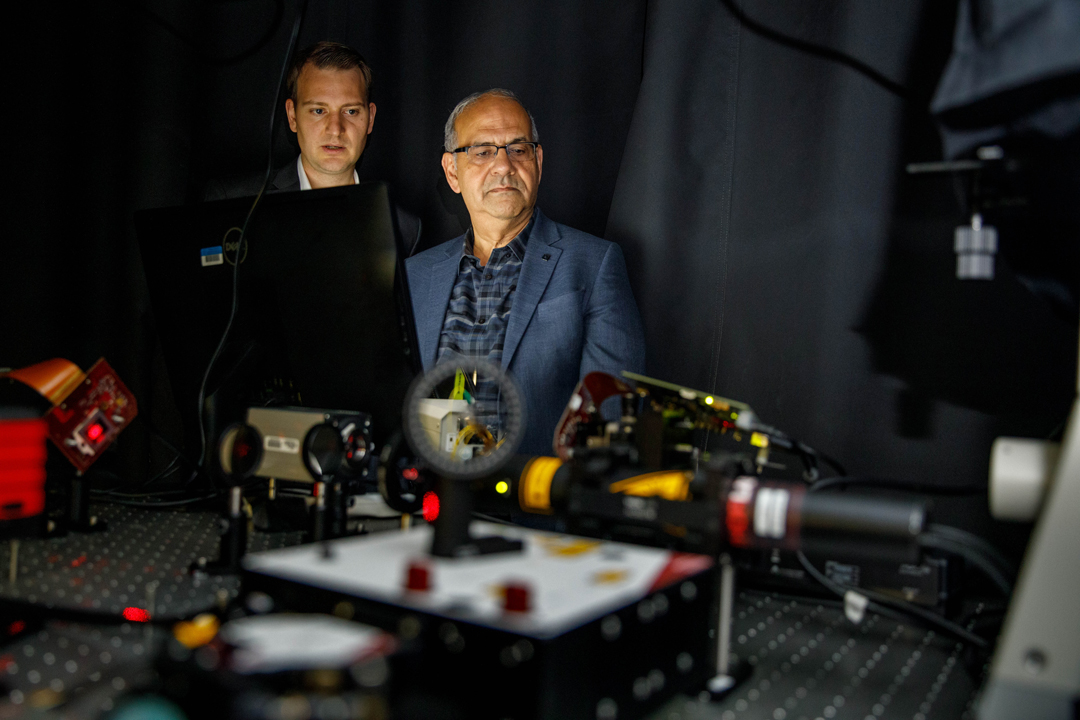Dr. Volker Sorger and Dr. Tarek El-Ghazawi have recently received 3 grants totaling over $5.1 million in funding from various institutions including the Office of Naval Research (ONR), the Army Research Office (ARO), and the Airforce Office of Scientific Research (AFOSR). Their general collaborative efforts focus on developing new processors and computers using light (i.e. photonics as opposed to electronics). Drs. El-Ghazawi and Sorger are looking to revolutionize today’s technologies from small electronic systems to larger computing systems including day to day IOT applications (e.g. smart home devices) to broader military and banking applications (e.g. military drones and encryption in banking). The inter-disciplinary work is unique in the way that it brings different research backgrounds – Dr. El-Ghazawi, an international authority on high-performance computing and Dr. Sorger, whose research focuses closely on opto-electronic devices and circuits, plasmonics, and nanophotonics – together to solve complex emerging issues in computing. Dr. Sorger attributes their success precisely to this which drives their innovation and outside-the-box thinking.
As Dr. Sorger sees it, the world is entering the fourth industrial revolution. In this era of digitalization, data everywhere is becoming ubiquitous. The challenge now is how it is processed, and new research directions are now looking for the hardware and computing solutions for the data-driven era. In the past, the electronic and computing industries have been following a “roadmap” set by Moore’s Law, but we are reaching its fundamental limits. In conjunction with the end of Moore’s Law as the driving force in computing, the implementation of recent initiatives such as the National Strategic Computing Initiative, the National Quantum Initiative, IEEE’s Rebooting Computing Initiative, and DARPA’s AI Next Campaign has set the pace and direction of innovative research. As demands for higher data processing capabilities continue to increase, such as techniques driven by machine learning, engineers are facing increased performance issues and challenges of scalability, reliability, and power-efficiency. The emerging trend that has been employed to tackle some of these issues shows a shift towards optics and photonics, which can send more data through the same channels faster and can have non-iterative systems designs processing information in the analog domain rather than only digitally.
The project “Photonic Convolutional Processor for Network Edge Computing” – supported by the $3.1M ONR grant – is focused on building an optical system capable of machine learning and feature extraction via a convolutional neural network. The group is looking to create an optical classification system with an extremely high data throughput that can be used in image processing and edge detection, for example. The goal of the project is to enable a system that can process at the speed-of-light – thus enabling near real-time information processing – and produce a processor that can do more operations per second without requiring as much power. The work is being done in conjunction with researchers at UCLA and UT Austin as well as Omega Optics, Inc (Dr. Sorger is the PI on the grant with Dr. El-Ghazawi as Co-PI). This technology is sought after by the defense sector as it can be applied to signal processing in the RF domain for tracking and timely decision making and is of use in civilian applications as well such as in autonomous vehicles.
Additionally, the pair of researchers were recently awarded a $1.25M ARO Grant (Dr. Sorger is the PI, with Dr. El-Ghazawi as Co-PI) in which the teams aim to develop an ulta-fast photonic processor that can revolutionize security applications that use public key cryptographic algorithms, which is an encryption technique and key algorithm for secure data communication. In the project entitled “Fourier Optics Multiplication Accelerator for Convolutional Neural Networks and Cryptographic Applications” they will study the overall performance of the optical system and how it performs modular multiplications for real-time probabilistic and cryptographic computing. Research professors, Yousra Alkabani and Mario Miscuglio are helping the duo build the novel processing system that can handle up to 1 Peta operation per second when scaled up without the power cost current systems have today. The work will have a critical impact for security applications.
Dr. El-Ghazawi was named the PI with Dr. Sorger as Co-PI on a $675K award from AFOSR for a project entitled “RANC: A Residue Arithmetic Nanophotonic Computer.” They’ll work to develop an integrated photonics computing system based on the residue number system (RNS). The work on the project was based off the question of whether processing can be done while a photon is flowing through the network in consideration of the properties of photons – namely, because it can never stop and is always propagating. In light of this, they realized they can carry out mathematical arithmetic within nanophotonics. By choosing a path through a photonic network, the operations can be processed much faster and more efficiently, giving rise to the innovative processing-in-network paradigm.
To date, Drs. Sorger and El-Ghazawi have begun the process for and received well over a dozen patents for this technology. Their efforts to commercialize the technology they are working on has been supported by the Technology Commercialization Office (TCO). Their research efforts have been supported and bolstered by the resources and facilities available on campus as well – specifically the Clean Room Facility in the Science and Engineering Hall and GWU’s Nanofabrication and Imaging Center (GWNIC). Since they began their pioneering research in 2015, Drs. El-Ghazawi and Sorger have jointly secured funding from multiple organizations totaling around $8M for their groundbreaking work with nanophotonics and optical architectures that explores the answers to post-Moore’s Law Computing and information processing.
Dr. Sorger’s Group from the Orthogonal Physics Enabled Nanophotonics (OPEN) Lab includes one Assistant Research Professor, Mario Miscuglio, 2 Postdoctoral Associates, and 10 Doctoral Students.
Dr. El-Ghazawi’s Group from the High-Performance Computing Lab is comprised of one Associate Research Professor, Yousra Alkabani and 6 Doctoral Students.


